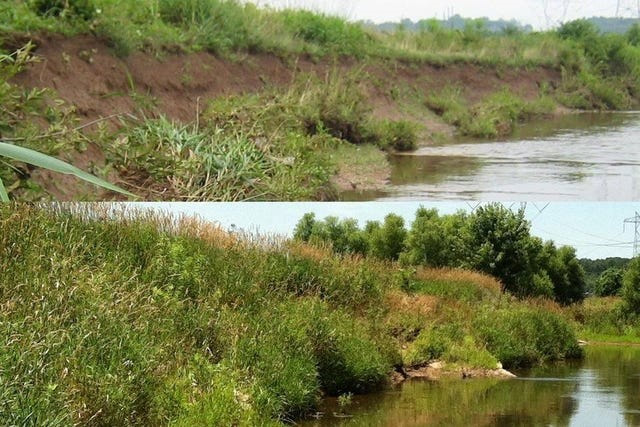CONSERVATION CORNER
A weekly blog for all things conservation
 By: Sarah K. Xenophon, Kristen Koch, and Jennifer R Fetter; Penn State Extension One of the many visual indicators you might use to assess the health of a stream is the amount of stream bank vegetation and other cover. You might find yourself walking along a stream or river, either on your property or when visiting a park or your local woods, and wish you had an easy way to understand the health of that stream. One indicator of stream health is the condition of the stream bank cover. When we talk about stream bank cover, or simply bank cover, we are talking about how much of the soil immediately adjacent to the water is covered by growing vegetation, stable debris, or bedrock material. This helps determine the health of a stream because it can tell us a lot about the relative stability of that stream. A stable stream maintains the same shape and flow pattern over time. A healthy, stable stream typically has more bank cover than an unhealthy stream. Bank cover helps reduce erosion by reducing the amount of soil exposed to passing water as it rushes into and down the stream. The stability of a stream is vital for any organisms that live in and around the stream and for protecting your property and nearby infrastructure (driveways, sewer lines, bridges, and more). Bank erosion causes sediment to wash into the stream. That sediment significantly impacts stream life, including a loss of wildlife habitat, higher levels of nutrients, and clouding of the water.
As banks collapse or slough off into a stream, the bushes, shrubs, and grasses also drop off into the stream. These stream-side plants, now lost, were providing shade and cover for fish, perches for birds, and habitat for many other wildlife. Stream dwelling insects are also impacted by bank erosion. As the soils and sediment settle on the stream bottom, they fill the rock spaces where stream-dwelling insects live, smothering them and taking away their feeding and breeding areas. Stream-dwelling insects are an essential food source for fish, birds, and other wildlife. Excessive amounts of erosion can also introduce excess levels of soil nutrients, such as Nitrogen and Phosphorus. Nutrients are essential for plant growth, and they lead to algal growth in the water. Excess algae causes a decrease in dissolved oxygen in the water. Many fish, shellfish, bugs, and other aquatic animals depend on dissolved oxygen for respiration. Depleted oxygen levels have led to many "dead zones" in America's largest fisheries. When stream banks erode, the soil dirties the stream water. Cloudy and muddy water blocks sunlight from reaching the stream bottom. Sunlight is vital for plant growth and fish to find their food. It can also make it harder for fish to obtain oxygen through their gills. Since plants are crucial to helping prevent erosion and keep stream banks stable, observing the amount of vegetation growing on stream banks can help measure the health of a stream over time. Questions to ask when considering your stream's health What percentage of the soil next to the stream is covered in vegetation? Are the stream banks tall and steep, or do they gently slope towards the stream? Has the stream maintained its shape over time, or are the banks collapsing into the water? The more vegetation, the healthier and more stable the stream is likely to be. Adding more native plants, such as live stakes, can help to increase your stream's health, provide more habitat, and protect you from property loss. You can learn more about assessing stream health using the First Investigation of Stream Health (FISH) protocol from Penn State Extension. The FISH protocol is based on procedures taken mainly from the PA DEP. In-Stream Comprehensive Evaluation (ICE) Surveys Manual; 2013 version. Please visit https://extension.psu.edu/backyard-stream-repair-series to learn about Penn State Extensions “Backyard Stream Repair Series” for additional information on this topic and to explore opportunities for the program on your property. The Bradford County Conservation District is committed to helping people manage resources wisely. You can visit the Bradford County Conservation District at 200 Lake Rd in Wysox across from the Wysox Fire Hall. Contact us at (570) 485-3144 or visit our web page at www.bccdpa.com.
0 Comments
Leave a Reply. |
AuthorsVarious staff at the Bradford County Conservation District Archives
July 2024
Categories
All
|
|
Bradford County Conservation District
Stoll Natural Resource Center 200 Lake Road, Suite E | Towanda PA 18848 Phone: (570)-485-3144 |
